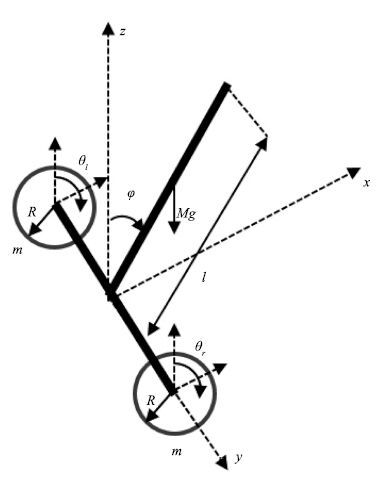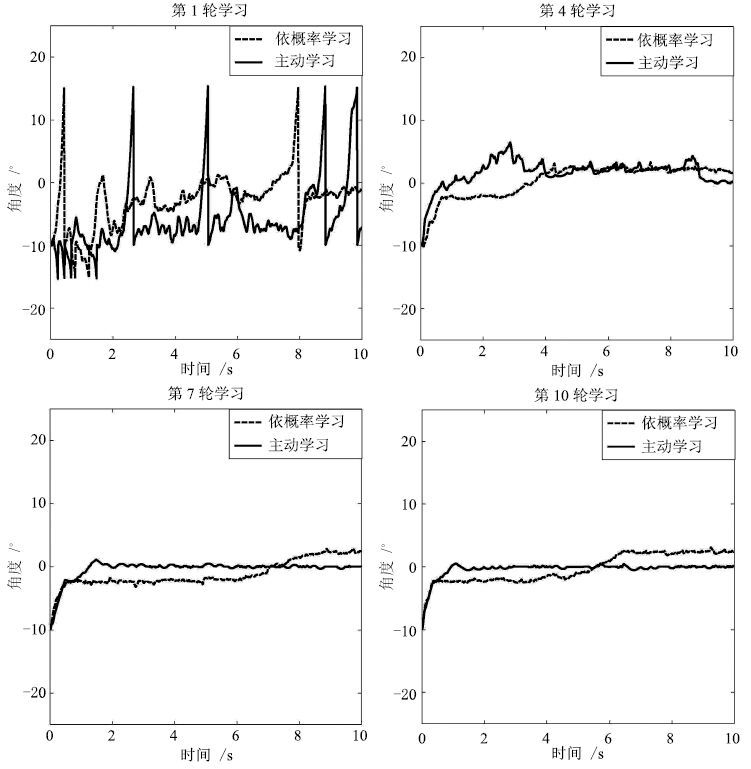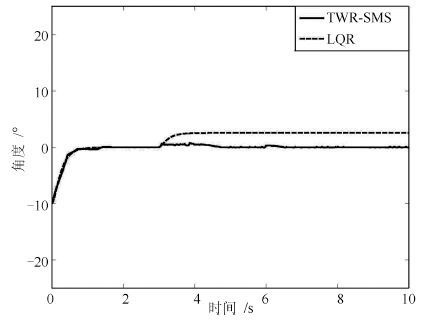Establishment of a Two-wheeled Robot's Sensorimotor System with Mechanism of Intrinsic Motivation
-
摘要: 针对两轮机器人运动平衡控制问题,为其建立起一种人工感知运动系统TWR-SMS(Two-wheeled robot sensorimotor system),使机器人在与环境的接触过程中可以通过学习自主掌握运动平衡技能.感知运动系统的认知系统以学习自动机为数学模型,引入好奇心和取向性概念,设计了能够主动探索环境以及主动学习环境的内发动机机制.实验结果证明内发动机机制的引入不仅提高了机器人的自学习和自组织特性,同时能够有效避免小概率事件的发生,稳定性较高.与传统线性二次型调节器(Linear quadratic regulator,LQR)控制方法的对比实验表明系统具有更好的鲁棒性.Abstract: Aimed at solving the problem of two-wheeled robot's balance control in movement, a kind of artificial sensorimotor system named TWR-SMS (two-wheeled robot sensorimotor system) is established, which endows the robot with the ability to keep balance through contacting with the environment. The cognitive system of the TWR-SMS is designed based on learning automaton, and the concepts of curiosity and orientation are introduced, as well as the mechanism of intrinsic motivation which can help the robot explore and learn the environment actively is designed. The experiments' results show that the mechanism of the intrinsic motivation not only improves the robot's ability of self-learning and self-organizing, but also avoids the small probability event effectively, which helps keep the robot with high stability. The comparative experiments with linear quadratic regulator (LQR) show that this system has better robustness.
-
表 1 两轮机器人物理参数
Table 1 Two-wheeled robot´s physical parameters
符号 意义 l 机器人身体长度 M 机器人身体质量 m 轮子质量 R 轮子半径 Jω 轮子转动惯量 τ 轮子转矩 表 2 TWR-SMS状态划分
Table 2 TWR-SMS state division
φ(º) $\dot \varphi $ (º/s) (-∞,-17.5) (-∞,-20) [-17.5,-12.5) [-20,-15) [-12.5,-7.5) [-15,-10) [-7.5,-2.5) [-10,-5) [-2.5,+2.5) [-5,+5) [+2.5,+7.5) [+5,+10) [+7.5,+12.5) [+10,+15) [+12.5,+17.5) [+15,+20) [+17.5,+∞) [+20,+∞) 表 3 小概率事件发生次数
Table 3 Numbers of small probability event
1 2 3 4 5 6 7 8 9 10 主动学习 3 9 4 0 0 0 0 0 0 0 依概率学习 0 2 7 8 12 13 12 7 10 7 表 4 主动学习下动作选择次数
Table 4 Motion selection numbers under active learning
主动学习 1 2 3 4 5 6 7 8 9 10 -5 191 119 80 27 14 3 4 2 3 2 -2 167 235 241 114 86 167 191 209 150 201 -0.1 130 122 182 145 115 233 213 243 226 359 0 149 120 117 186 59 108 123 133 83 156 0.1 152 128 131 355 653 333 194 213 396 81 2 140 170 146 117 66 156 172 199 140 201 5 71 106 103 56 7 0 3 1 2 0 表 5 依概率学习下动作选择次数
Table 5 Motion selection numbers under probabilistic learning
依概率学习 1 2 3 4 5 6 7 8 9 10 -5 186 95 73 61 43 30 29 30 44 29 -2 141 122 140 116 197 166 208 197 187 177 -0.1 144 166 217 214 220 237 206 203 231 258 0 137 170 200 215 199 189 196 194 199 172 0.1 148 177 202 181 174 179 172 173 153 174 2 112 161 117 162 132 162 168 175 154 156 5 132 109 51 51 35 37 21 28 32 34 -
[1] Chan R P M, Stol K A, Halkyard C R. Review of modelling and control of two-wheeled robots. Annual Reviews in Control, 2013, 37(1):89-103 doi: 10.1016/j.arcontrol.2013.03.004 [2] Hu L Y, Ieee H L, Xu S P, Zhang H. A controller combining positive velocity feedback with negative angle feedback for a two-wheeled robot. Cybernetics and Information Technologies, 2015, 15(2):159-170 http://cn.bing.com/academic/profile?id=2259284260&encoded=0&v=paper_preview&mkt=zh-cn [3] Suprapto B Y, Amri D, Dwijayanti S. Comparison of control methods PD, PI, and PID on two wheeled self balancing robot. In:Proceedings of the 2014 Electrical Engineering, Computer Science and Informatics. Yogyakarta, Indonesia, 2014.67-71 [4] Alarfaj M, Kantor G. Centrifugal force compensation of a two-wheeled balancing robot. In:Proceedings of the 11th International Conference of Control, Automation, Robotics and Vision. Singapore:IEEE, 2010.2333-2338 [5] Bonafilia B, Gustafsson N, Nyman P, Nilsson S. Self-balancing two-wheeled robot[Online], available:http://seb-astiannilsson.com/wp-content/uploads/2013/05/Selfbalan-cing-two-wheeled-robot-report.pdf,February2,2016 [6] Li C G, Gao X S, Huang Q, Dai F Q, Shao J, Bai Y, Li K J. A coaxial couple wheeled robot with T-S fuzzy equilibrium control. Industrial Robot:An International Journal, 2011, 38(3):292-300 doi: 10.1108/01439911111122798 [7] Wardoyo A S, Hendi S, Sebayang D, Hidayat I, Adriansyah A. An investigation on the application of fuzzy and PID algorithm in the two wheeled robot with self balancing system using microcontroller. In:Proceedings of the 2015 International Conference on Control, Automation, and Robotics. Singapore:IEEE, 2015.64-68 [8] Li Z J, Xu C Q. Adaptive fuzzy logic control of dynamic balance and motion for wheeled inverted pendulums. Fuzzy Sets and Systems, 2009, 160(12):1787-1803 doi: 10.1016/j.fss.2008.09.013 [9] Li Z J, Zhang Y N. Robust adaptive motion/force control for wheeled inverted pendulums. Automatica, 2010, 46(8):1346-1353 doi: 10.1016/j.automatica.2010.05.015 [10] Li Z J, Yang C G. Neural-adaptive output feedback control of a class of transportation vehicles based on wheeled inverted pendulum models. IEEE Transactions on Control Systems Technology, 2012, 20(6):1583-1591 doi: 10.1109/TCST.2011.2168224 [11] Raphael B. The robot "Shakey" and "his" successors. Computers and People, 1976, 25(10):7-21 doi: 10.1057/ejis.2011.11 [12] Ruan X G, Chen J, Yu N G. Thalamic cooperation between the cerebellum and basal ganglia with a new tropism-based action-dependent heuristic dynamic programming method. Neurocomputing, 2012, 93:27-40 doi: 10.1016/j.neucom.2012.04.012 [13] 戴丽珍, 杨刚, 阮晓钢. 基于AOCA仿生学习模型的两轮机器人自主平衡学习研究. 自动化学报, 2014, 40(9):1951-1957 http://www.aas.net.cn/CN/abstract/abstract18465.shtmlDai Li-Zhen, Yang Gang, Ruan Xiao-Gang. Self-balance learning of two-wheeled robot based on autonomous operant conditioning automata. Acta Automatica Sinica, 2014, 40(9):1951-1957 http://www.aas.net.cn/CN/abstract/abstract18465.shtml [14] Piaget J. The Origins of Intelligence in Children. New York:International Universities Press, 1952. [15] Lee D D, Seung H S. Learning in intelligent embedded systems. In:Proceedings of the 1999 Embedded Systems Workshop. Cambridge, USA:The USENIX Association, 1999.133-139 [16] Natale L, Orabona F, Berton F, Metta G, Sandini G. From sensorimotor development to object perception. In:Proceedings of the 5th IEEE-RAS International Conference on Humanoid Robots. Tsukuba:IEEE, 2005.226-231 https://www.researchgate.net/publication/224200083_Emergent_imitative_behavior_on_a_robotic_arm_based_on_visuo-motor_associative_memories [17] Dong D Q, Franklin S. Sensory motor system:modeling the process of action execution. In:Proceedings of the 36th Annual Conference of the Cognitive Science Society. Quebec, Canada, 2014.2145-2150 [18] Laflaquiére A, O'Regan J K, Argentieri S, Gas B, Terekhov A V. Learning agent's spatial configuration from sensorimotor invariants. Robotics and Autonomous Systems, 2015, 71:49-59 doi: 10.1016/j.robot.2015.01.003 [19] Teuliére C, Forestier S, Lonini L, Zhang C, Zhao Y, Shi B, Triesch J. Self-calibrating smooth pursuit through active efficient coding. Robotics and Autonomous Systems, 2015, 71:3-12 doi: 10.1016/j.robot.2014.11.006 [20] Oudeyer P Y, Kaplan F. What is intrinsic motivation? a typology of computational approach. Frontiers in Neurorobotics, 2007, 1:6 [21] Schmidhuber J. Curious model-building control systems. In:Proceedings of the 1999 IEEE International Joint Conference on Neural Networks. Singapore:IEEE, 1991.1458-1463 http://cn.bing.com/academic/profile?id=1646752922&encoded=0&v=paper_preview&mkt=zh-cn [22] Oudeyer P Y, Kaplan F. Intelligent adaptive curiosity:a source of self-development. In:Proceedings of the 4th International Workshop on Epigenetic Robotics. Lund University Cognitive Studies, 2004.127-130 http://groups.lis.illinois.edu/amag/langev/ref/oudeyer06discoveryOfCommunication.html [23] Baranes A, Oudeyer P Y. Intrinsically motivated goal exploration for active motor learning in robots:a case study. In:Proceedings of the 2010 IEEE/RSJ International Conference on Intelligent Robots and Systems. Taipei, China:IEEE, 2010.1766-1773 [24] Der R, Martius G. Novel plasticity rule can explain the development of sensorimotor intelligence. Proceedings of the National Academy of Sciences of the United States of America, 2015, 112(45):E6224-E6232 doi: 10.1073/pnas.1508400112 [25] Schyns P G, Gosselin F, Smith M L. Information processing algorithms in the brain. Trends in Cognitive Sciences, 2009, 13(1):20-26 doi: 10.1016/j.tics.2008.09.008 [26] 阮晓钢, 蔡建羡, 李欣源, 赵建伟. 两轮自平衡机器人的研究与设计. 北京:科学出版社, 2012.Ruan Xiao-Gang, Cai Jian-Xian, Li Xin-Yuan, Zhao Jian-Wei. Research and Design of Two-Wheeled Balancing Robot. Beijing:Science Press, 2012. -





 下载:
下载:







